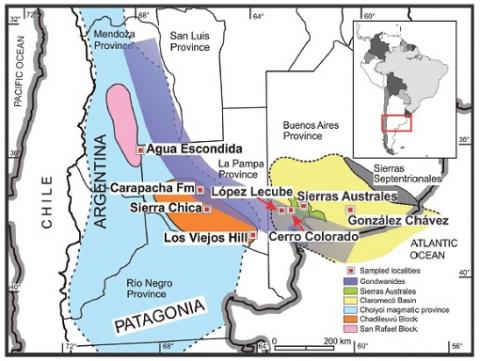Arzadún Guadalupe, Tomezzoli Renata Nela, Tickyj Hugo, Cristallini Ernesto Osvaldo and Gallo Leandro Cesar
2 018
Tectonics - Problems of Regional Settings chapter 2 2018
The anisotropy of magnetic susceptibility (AMS) is an effective tool to measure the rock
petrofabric and it allow analyzing the tectonic stress. The southwest boundary of Gondwana
in South America is the counter-part of the Cape fold belt of South Africa and its
geological evolution is still a subject of debate. Samples of different localities of this sector
were analyzed with the AMS technique, from Buenos Aires, La Pampa and Mendoza
province. For rocks of Permian age, there is a clear regional magnetic signature indicating
aNW-SE elongation direction and a NE-SW shortening. The ASM patterns obtained in the
oldest rocks are complex, probably as the result of stress interference in the magnitudes,
space and time with different pulses of the orogenic activity developed from the Middle
Devonian to the Permian. In the southwest of Gondwana, small continental plates were
accreted to the main continent mass during the Middle Devonian. The Permian deformation
has been interpreted as the consequence of a paleogeographic re-organization of
Gondwana that moves to lowest latitudes to makes the Pangea continent during the
Triassic. This younger deformation evidences an orogenic front migration and attenuation
to the foreland basin.
petrofabric and it allow analyzing the tectonic stress. The southwest boundary of Gondwana
in South America is the counter-part of the Cape fold belt of South Africa and its
geological evolution is still a subject of debate. Samples of different localities of this sector
were analyzed with the AMS technique, from Buenos Aires, La Pampa and Mendoza
province. For rocks of Permian age, there is a clear regional magnetic signature indicating
aNW-SE elongation direction and a NE-SW shortening. The ASM patterns obtained in the
oldest rocks are complex, probably as the result of stress interference in the magnitudes,
space and time with different pulses of the orogenic activity developed from the Middle
Devonian to the Permian. In the southwest of Gondwana, small continental plates were
accreted to the main continent mass during the Middle Devonian. The Permian deformation
has been interpreted as the consequence of a paleogeographic re-organization of
Gondwana that moves to lowest latitudes to makes the Pangea continent during the
Triassic. This younger deformation evidences an orogenic front migration and attenuation
to the foreland basin.

